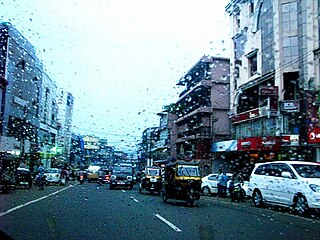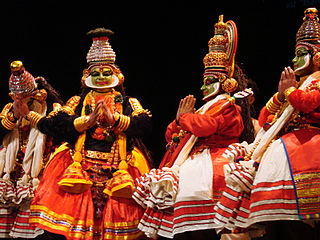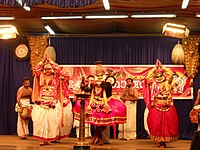
Kathakali is a traditional form of Indian Classical Dance, and one of the most complex forms of Indian theatre. It is a play of verses. These Verses called Kathakali literature or Attakatha. Mostly played in the courts of Kings and Temple festivals. Hence it known as suvarna art forms. This performance uses the navarasas of Bharathan, the Guru of Indian theatre. Makeup and costumes are very unique and huge. Normally it represent Kerala Art. It is native to the Malayalam-language southwestern region of Kerala and is almost entirely practiced by Malayali people.

The Gita Govinda is a work composed by the 12th-century Hindu poet, Jayadeva. It describes the relationship between Krishna, Radha and gopis of Vrindavan.
Guruvayurappan also rendered as Guruvayoorappan, is a form of Vishnu worshipped mainly in Kerala, India. He is the presiding deity of the Guruvayur Temple, who is worshipped as Krishna in his child form, also known as Guruvayur Unnikkannan. The temple is located in the town of Guruvayur, Thrissur, Kerala, which is named after the deity.

Guruvayur Temple is a Hindu temple dedicated to Guruvayurappan, located in the town of Guruvayur in Kerala, India. Administrated by the Guruvayur Devaswom Board, it is one of the most important places of worship for Hindus in Kerala and Tamil Nadu and is often referred to as Bhuloka Vaikunta. The temple is classified among the 108 Abhimana Kshethram of Vaishnavate tradition.
Acyuta Piṣāraṭi was a Sanskrit grammarian, astrologer, astronomer and mathematician who studied under Jyeṣṭhadeva and was a member of Madhava of Sangamagrama's Kerala school of astronomy and mathematics.
Melpathur Narayana Bhattathiri, third student of Achyuta Pisharati, was a member of Madhava of Sangamagrama's Kerala school of astronomy and mathematics. He was a mathematical linguist (vyakarana). His most important scholarly work, Prakriya-sarvasvam, sets forth an axiomatic system elaborating on the classical system of Panini. However, he is most famous for his masterpiece, Narayaneeyam, a devotional composition in praise of Guruvayurappan (Krishna) that is still sung at Guruvayur Temple.

Kottakkal is a major municipal town in Malappuram district in Kerala, having 32 wards.It is one of the four municipalities in Tirur Taluk, besides Tirur, valanchery, and Tanur. it is a part of Malappuram metropolitan area and a growing city in Kerala. The town is best known for the Arya Vaidya Sala, one of the top Ayurvedic health centres of the world. Kottakkal is also a major growing commercial, educational, and healthcare hub in South Malabar. The town lies on Mumbai–Kanyakumari National Highway 66.

Tirur is a major municipal town in Tirur Taluk, Malappuram district, in the Indian state of Kerala, spread over an area of 16.55 square kilometres (6.39 sq mi).

K. V. Krishna Iyer (1896–1982) was a professor of history at Zamorin's Guruvayurappan College, Kozhikode. He is considered an authority on the history of Kerala. He has authored important historical books namely The Zamorins of Calicut, History of Kerala and History of Guruvayur, which are based on facts from his personal research on available records like Olagranthangal, Vattezhuthu and Kolezhuthu inscribed on copper plates. His radio talks on the arrival of the Portuguese, Dutch, Arabs on the Malabar coast and their interaction with the locals were highly appreciated; as also his newspaper articles on Kerala land tenure. Two of his students, P. P. Ummer Koya and C. H. Mohammed Koya, ministers in the Kerala cabinet compelled him to adorn many committees on History, Archeology and Anthropology of Kerala.

Tanur is a coastal town, a municipality, and a block located in Tirur Taluk, Malappuram district, Kerala, India. It is located on the Malabar Coast, 9 kilometres (5.6 mi) north of Tirur and 9 kilometres south of Parappanangadi. It is the 17th-most populated municipality in the state, the fourth-most populated municipality in the district, and the second-most densely populated municipality in Malappuram district, having about 3,568 residents per square kilometre as of the year 2011.

Narayana Teertha was a Hindu saint and composer, known to be a devotee of the deity Krishna.

Krishnanattam is a temple art in Kerala, India. It is a dance drama and presents the story of Krishna in a series of eight plays and was created by Manaveda, the then Zamorin Raja of Calicut in northern Kerala. The eight plays are: Avataram, Kaliyamardanam, Rasakrida, Kamsavadham, Swayamvaram, Banayuddham, Vividavadham and Swargarohanam. It survives in its glory at the Guruvayur Sri Krishna temple.

The Narayaniyam is a medieval-era Sanskrit text, comprising a summary study in poetic form of the Bhagavata Purana. It was composed by Melpathur Narayana Bhattathiri, a celebrated Sanskrit poet of Kerala. Even though the Narayaniyam is believed to be composed as early as 1585 CE, the earliest available manuscripts came only after more than 250 years. The Bhagavata Purana is a major Hindu scripture consisting of about 18,000 verses, mainly devoted to the worship of Krishna. The work contains detailed descriptions of Guruvayurappan, a regional form of Krishna, and the temple town of Guruvayur.

Poonthanam Nambudiri was a famous poet and a devotee of Guruvayurappan, who lived in Keezhattoor in what is now Malappuram district, Kerala, India. He is remembered for his masterpiece, Jnanappana which means "the song of divine wisdom" in Malayalam. His other chief poems in Malayalam are Bhasha Karnamritam and Kumaraharanam or Santanagopalam Pana. His other works include Raghaviyam, Vishnuvilasam and Sitaraghavam in Sanskrit and Vishnugeeta and Panchatantram in modern Malayalam.
Ramanattam is a temple art in Kerala, India. The dance drama presents the story of Rama in a series of eight plays and was created under the patronage of Veera Kerala Varma alias Kottarakkara Thampuran. Ramanattom is based on a story from the epic Ramayana, covering the incarnation of Rama to the Rama-Ravana War, Ravana's defeat and Rama's crowning at Ayodhya. The story was written by Kottarakkara Thampuran and is divided into eight poetic sections so that each section can be enacted in one day. These eight sections are puthrakameshti, seetha swayamvaram, vicchinnabhishekam, kharavadham, balivadham, thoranayudham, sethubandhanam and yudham (war). Ramanattam is widely believed to be the immediate stem of the well known classical art form of Kerala, Kathakali.

Tirur Taluk comes under Tirur revenue division in Malappuram district in the Indian state of Kerala. Its headquarters is the town of Tirur. Tirur Taluk contains four municipalities - Tanur, Tirur, Kottakkal, and Valanchery. Most of the administrative offices are located in the Mini-Civil Stations at Tirur, Kuttippuram, and Tanur. Most of the villages in present-day Tirur Taluk were parts of the medieval Kingdom of Tanur (Vettathunadu). The port of Tanur was an important port town in the southwestern coast of India during medieval period.

His Highness Kizhakke Covilakam Manavedan Raja alias Cheriyanujan Raja (1855–1937) was an Indian aristocrat and administrator. He was the titular Zamorin of Calicut from 1932 to 1937.
Puthiya Kovilakathu Sree Manavedan Raja was the titular Zamorin of Calicut (Samoothiri) from 16 August 2003 to 27 March 2013. He was the 147th Samoothiri, and the last to hold power over Guruvayur Temple. He was married to Smt. Bharathy Thamburatty from the royal family of Nilambur Kovilakam.
The history and culture of Kottarakkara in Kerala, India has a rich history. it used to be a palace in the 14th and 15th centuries. In fact, the name "Kottarakkara" means "land of palaces."





















